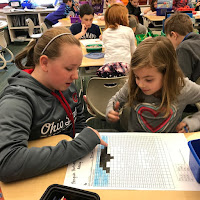November Neighbors and Number Use
| We estimated how tall the pumpkin was using just one unifix cube- and then stacked them for a closer count. |
After guessing "how many inches around" their pumpkins would turn out to be...each person measured about how many actual inches. Each table pumpkin was either 17 or 18 inches! We also estimated how many seeds were in each pumpkin- and then put the seeds into piles of ten so it would be easier to count them. For the end of the month we plan on studying turkeys a well as continuing our investigation into animal adaptations for winter. Later we will compare how native people of long ago adapted to their environments.











